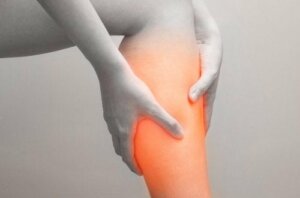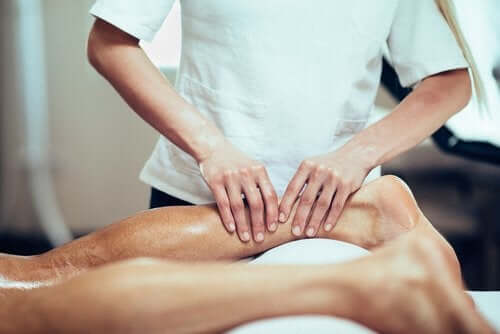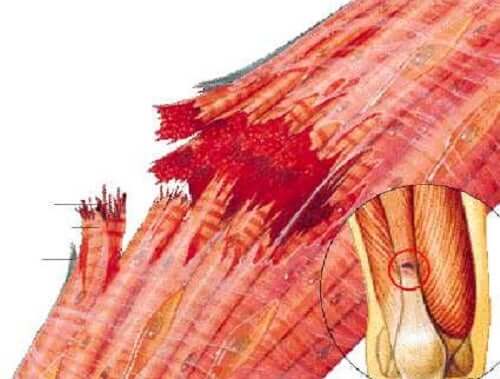What Are Calf Muscle Injuries and How Are They Treated?

The calf consists of two muscles–the gastrocnemius and the soleus. The calf muscles don’t only help flex the lower leg, but they’re also involved in fast movements such as jumping and short runs. Calf muscle injuries are a sudden and serious injury that may require medical attention.
Causes of calf muscle injuries
Calf muscle injuries occur most often during sports when you have to push quickly with your foot to suddenly accelerate. However, they can also occur when you jump or make a quick change of direction.
That sudden movement can overload the calf, causing it to stretch beyond its normal limits, which can lead to tearing of the calf muscle. People who play sports like tennis or basketball are more likely to suffer this type of injury.
When the injury occurs, you may hear a snap or feel a tearing sensation in your calf. In addition, other symptoms may appear such as:
- Pain
- Swelling
- Bruising
- Problems walking or bearing weight with the injured leg
Read also: Home Remedies to Soothe Sore Muscles
Symptoms of calf muscle injuries

The symptoms depend on the severity of the injury. If it’s a simple strain, then you’ll feel a strong pull on your lower leg. You may even experience shooting pain.
However, a tear in the calf muscle causes very sharp pain and you’ll barely be able to walk. There are three degrees depending on the severity of the injury.
Grade 1 strain
A grade 1 strain involves micro-cracking of muscle fibers by up to 10%. It involves mild pain in the back of the leg and near the heel. In this case, there’s hardly any loss of strength and movement and it’s possible to continue practicing sports as usual.
Full recovery will take place within several weeks of the injury. This will depend on the percentage of fibers involved and the treatment.
Grade 2 strain
A grade 2 strain involves more extensive damage and greater pain. In a grade 2 tear, there’s a significant loss of muscle strength and mobility. At the same time, swelling is more severe and bruising appears quickly. In addition, there are limitations when it comes to physical activity.
Experts consider the gastrocnemius muscle to be at high risk for muscle tearing. This is because it crosses the knee and ankle and has a high proportion of rapidly contracting muscle fibers.
Grade 3 strain
In this case, there’s a complete breakdown of the muscular system. Here, the pain is very acute and the inflammation is severe and immediate. There’s also a noticeable bulge in the calf as the broken part contracts.
The inability to walk is characteristic of grade 3 calf muscle strains. The muscle fibers can’t come together and the situation requires emergency intervention.
You may be interested: Types of Food that Strengthen Tendons and Muscles
The treatment of calf muscle injuries

The most effective treatment protocol for calf muscle tears is known as R.I.C.E, which stands for:
- Rest
- Ice
- Compression
- Elevation
The first step is rest–temporarily stopping all physical activity. Then, the next step involves applying ice or cold therapy to the injured area as soon as possible. This helps to stop internal bleeding and reduce swelling.
It’s advisable to apply ice or cold for 10-15 minutes every hour and then reduce the frequency as the pain and swelling decrease. It’s also helpful to compress the ice against the injury with a compression bandage.
If the tear is more severe, it’s helpful to know which of the two calf muscles is most affected. For this reason, an ultrasound or MRI may be needed to better diagnose the location and extent of the injury.
Grade 3 strains as well as some grade 2 strains need surgery to connect and repair the damaged muscle and tendon. In this case, time is of the essence, because the longer a muscle is torn and contracted, the harder it is to stretch and achieve adequate muscle tone.
After surgery, the R.I.C.E. protocol and the guidelines indicated by the physical therapist are applied to strengthen the muscle.
All cited sources were thoroughly reviewed by our team to ensure their quality, reliability, currency, and validity. The bibliography of this article was considered reliable and of academic or scientific accuracy.
-
López, A. A. (1996). Bases científicas para el tratamiento del desgarro muscular Movilización versus inmovilización. Revista Española de Cirugía Osteoarticular.
-
Vaisman Burucker, A., Scheu Goncalves, M., Araya Proboste, I., Calvo Mena, R., Figueroa Poblete, D., Gallegos Angulo, M., … Conget Molina, P. (2018). ¿Podemos Mejorar La Cicatrización de un Desgarro Muscular Masivo? Revista Chilena de Ortopedia y Traumatología. https://doi.org/10.1055/s-0038-1641564
-
José Bugeda Becerril. (2013). DISTENSIÓN MUSCULAR EN EL DEPORTE: TRATAMIENTO FISIOTERÁPICO. Diplomado En Fisioterapia Por La Universidad Alfonso X El Sabio de Madrid .
This text is provided for informational purposes only and does not replace consultation with a professional. If in doubt, consult your specialist.








